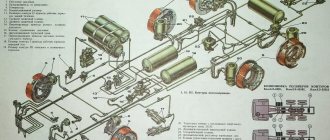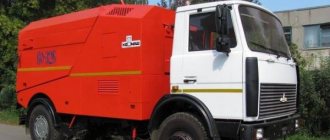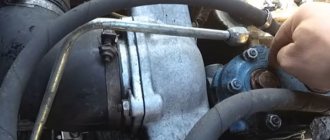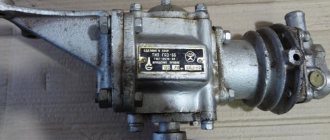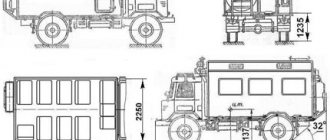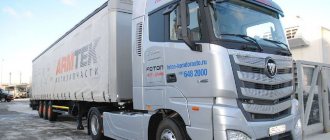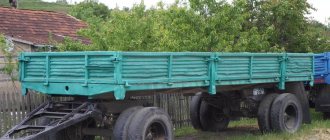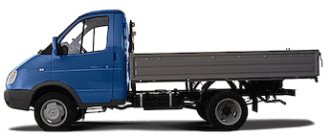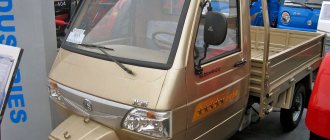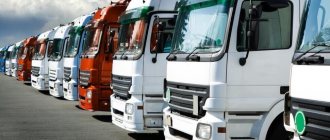Main stages of work
Like car body repairs, these restoration works are also carried out in accordance with the rules and consistently.
The skeleton of a car can be restored to order even if the car is involved in a major accident. Let's look at the main stages of restoration work on a truck body:
- First, a qualified inspection is carried out;
- Body geometry is diagnosed;
- Parts are cleaned of traces of rust and paintwork;
- Easily removable body elements are restored;
- Straightening, straightening and bringing the body elements to the original geometry are carried out;
- The frame is being repaired;
- Painting and anticorrosive work is being carried out.
Advantages of argon welding
As for welding work, argon welding is used for body elements made of non-ferrous metal. The latter provides a strong and reliable connection of body elements. Argo-arc welding is also called universal, because it can solve a wide range of problems faced by a body repair specialist. This type of welding work is considered ultra-modern; it allows not only to efficiently repair body components, but also to save money on the purchase of new parts.
The most labor-intensive task in body repair of trucks is the restoration of the bus frame. This complexity is explained by the large dimensions of the latter. On the other hand, if a garage or service is equipped with a modern type of painting chamber, then cars up to 14-15 meters long can be restored in such a box.
Car body
The main body types of a passenger car: a – sedan; b – station wagon; c – hatchback; g – minivan.
Usually load-bearing; consists of dept. panels connected to each other. Basic material – steel, with end. 20th century composites are being used more and more widely. materials. Outside K. a. Protected by energy-absorbing bumpers. They are divided into several. types (depending on the general layout of the car and the number of passenger seats), the list of which (despite some discrepancies) is the same for most countries, including the Russian Federation.
Sedan (in the UK and Japan Saloon, in German-speaking countries Limousine) - a closed three-volume (one volume for the engine, a second for passengers, a third for luggage) car. with four (less often with two or six) doors and with two (sometimes with three) rows of seats; basic type of passenger car (Fig., a). If part of the sedan's roof opens above the rear seat it is a landau, if above the front seat it is a brogue, and if the middle of the roof is removable it is a targa. With the soft awning fully opening, K. a. called a convertible; when the hard one is removed - a convertible hardtop. If, with a soft awning, the side windows and pillars are removable and not lowered, this is a phaeton. Its variety is the station wagon phaeton - cargo-passenger car. with a folding roof along the entire length and removable side windows (typical for some off-road vehicles). If there is a rigid or retractable partition separating the driver from the passengers, K. a. called a limousine.
Coupe is a two-door, two-seater closed car, usually with blind (non-rolling) rear side windows. The same open K. a. with a soft folding awning is called a roadster.
A station wagon (in the USA Station Wagon, or Wagon; in the UK Estate; in German-speaking countries Kombi) is a closed two-volume (one volume for the engine, the second for passengers and luggage) cargo-passenger vehicle. with luggage compartment located behind the back of the rear seat (Fig., b). Most station wagons are technically based on sedans, the roof of which is extended at the rear and the trunk is combined with the passenger compartment, due to which the trunk has a larger volume than that of a sedan. Mn. station wagons have the ability to transform the rear part of the car. by folding all rows of seats except the first. If there are no rear windows, the station wagon is called a van; if there is a loading platform behind the driver's cab, it is a pickup truck.
Hatchback (combi in the USSR) is a two-volume car with a rear luggage door and, as a rule, a sloping roof line (Fig., c); It differs from the station wagon in the length of the rear overhang - on the hatchback it is short, while on the station wagon it is the same as on the base sedan, or longer.
Minivan - single-volume (hoodless) K. a. with two or three rows of seats (Fig., d); something between a car and a minibus.
1.1. Truck frame
Car classification
A frame is most often used as the supporting structure of a truck system (Fig. 105). There are spar and spinal frames.
The spar frame consists of two longitudinal stamped cans of channel cross-section - spars, interconnected by several cross members. This frame is called a spar frame. Cross members are usually stamped and serve not only to connect the side members together and give the entire structure the necessary rigidity, but also to fasten various components of the car. Low carbon steel is usually used to make frame elements. The connection of spars and cross members is most often done using rivets. In the necessary places, various brackets and other parts for installing vehicle components are attached to the side members and cross members, also with rivets or bolts.
Rice. 105. KamAZ-5320 vehicle frame: 1 — front buffer mounting bracket; 2 - first cross member; 3 — right spar; 4 — front engine mount bracket; 5 — front axle spar extension insert; 6 - two halves of the second cross member; 7 — rear engine mount bracket; 8 — bracket for fastening the supporting support of the power unit; 9 — two halves of the third cross member; 10 - fourth cross member; 11 — extension insert of the intermediate bridge spar; 12 — two halves of the fifth cross member with reinforcing gussets; 13 — extension insert of the rear axle spar; 14 - sixth cross member; 15 — rear cross member brace; 16 — reinforcing rear cross member; 17 — rear cross member; 18 — brace gusset; 19 — rear cross member brace brace; 20 — left spar; 21 — rear bracket of the front suspension; 22 — bracket for fastening the upper ear of the shock absorber; 23 — water radiator mounting bracket; 24 — front suspension bracket
Welding in the manufacture of frames is used quite rarely, since the side frames of trucks are relatively flexible to bending, and especially torsion, and welds under these conditions are a source of crack formation.
The ability of the frame to deform under torsional loads avoids unnecessarily high stresses at the joints.
The truck cabin is fixed to the frame at three or four points using elastic devices, and deformations of the frame when the vehicle moves on an uneven road do not cause corresponding deformations of the cabin.
In rare cases, trucks use a so-called backbone frame, which is a large-diameter steel pipe running along the vehicle along its longitudinal axis. In the front part, the frame bifurcates, forming two longitudinal spars that serve to install the engine and gearbox. A cardan transmission is located inside the pipe. In this case, the driving axles of the car have sprung gearboxes, from which torque is supplied to the wheels by swinging axle shafts.
Features of the design and maintenance of a truck
Some maintenance issues are closely related to the specific design of trucks. Unprepared motorists who switched from cars to trucks do not immediately delve into all the nuances of maintenance.
At first glance, almost everything in the design and maintenance of trucks is the same or very similar to passenger cars. There are regulations for EO, TO-1, TO-2 and so on. Indeed, the main maintenance points do not differ from those for passenger cars. But there are still some key differences.
Let's briefly look at the important points when carrying out truck maintenance, which are not always given enough attention:
- Mandatory inspection of the frame and body joints. Large masses carried by trucks place significant stress on the frame. And there are often cases when important load-bearing elements break along the route.
- Lubrication of springs, injection of king pins, universal joints and other moving parts equipped with grease fittings. You should definitely familiarize yourself with the truck’s lubrication chart and remember to lubricate all moving parts.
- A thorough check of not only the brake pads, but also the lines, working cylinders, fluid level in the reservoir (for the hydraulic system), the functionality of the brake valve and the integrity of the receivers (for the pneumatic system). A loaded vehicle with problems in the braking system is the most dangerous road user.
Due to all the features discussed, trucks usually receive more attention during maintenance than passenger cars. The most important aspect of trouble-free operation of a truck is the use of high-quality parts and materials during the repair and maintenance process. The online store of truck spare parts TopDetal.ru sells high-quality components for trucks of domestic and foreign production. In our catalog you will find a large assortment of spare parts, and if the required part is not in stock, we are always ready to bring it to order! For more information please call 8 800 444-75-16.
General transmission structure. Trucks. Transmission and gearboxes
Classification of cars by body type
General transmission device
The transmission is units and mechanisms that interact with each other and connect the engine crankshaft with the drive wheels of the car. The transmission transmits torque from the engine to the wheels. With its help, the driver can change the amount of torque, and when reversing, the direction of movement. Usually the driving wheels are the rear ones, but on vehicles whose characteristics include increased cross-country ability, most or all wheels can be driven.
To characterize a car, a wheel formula is used, in which the first digits indicate the number of wheels of the car, and the second digit indicates the number of driving wheels. For example, the formula (6x4) means that a car has six wheels, of which four are driving wheels. In three-axle cars, torque is transmitted to the intermediate drive wheels and rear drive wheels by one common shaft or separately by two shafts. In the first case, the intermediate bridge has a through drive shaft. Directly behind the engine there is a clutch, then a gearbox, a driveshaft, an intermediate axle, and a rear axle. It is a main gear with a center differential (distributing torque between these axles). In two-axle and three-axle vehicles with all drive wheels, a transfer case is provided to disengage the front axle drive. In road trains with trailers for driving on roads with hard ground surfaces, only the tractor has a transmission. On road trains intended for off-road driving, the drive axles of trailers have the transmission. The drive of additional equipment is carried out using a power take-off, which is connected to the gearbox.
Chassis
Chassis is a supporting device necessary to move a vehicle. The chassis includes all mechanisms and units designed to transmit force from the engine to the drive wheels, as well as to control and move the vehicle.
Chassis includes:
- transmission
- chassis
- steering
- braking system
The transmission is a set of mechanisms that transmit torque from the engine crankshaft to the drive wheels, as well as change the torque and speed of rotation of the drive wheels in magnitude and direction.
The transmission consists of:
- clutch 3
- gearbox 4
- cardan transmission 5
- drive axle 6
Rice. Components of the car: 1 - cabin; 2 — loading platform; 3 — clutch; 4 — gearbox; 5 — cardan transmission; 6 - driving axle.
The clutch is necessary for short-term separation of the engine and transmission when changing gears and for their smooth connection when starting off.
The gearbox (Gearbox) is designed to change the torque on the drive wheels, the speed and direction of movement of the vehicle by engaging different pairs of gears.
The cardan transmission is used to transmit rotation from the gearbox shaft to the drive axle at a certain angle.
The drive axle consists of mechanisms by which torque is increased and the rotation of the shafts is transmitted to the drive wheels at a right angle.
The chassis is designed to move the car. The rotational motion of the drive wheels when they engage with the ground surface is converted into forward motion of the vehicle.
Steering is necessary to change the direction of movement of the car.
The braking system is used to slow down and stop the vehicle.
The structure of the car in general terms
How does a car work? Not all Internet users know what systems any machine consists of. Many people are interested in this, but most of the materials on the Internet are too complex, full of automotive terms and not accessible enough for the masses. We decided to fill this gap in your knowledge.
Diagram showing the structure of a passenger car
As we see in this diagram, a machine is a rather complex mechanism consisting of several interconnected systems. Each of them performs its own, extremely necessary function. Therefore, if one of these systems fails, the car can rarely continue moving or loses controllability.
We can conditionally define the “three pillars” on which the structure of the car rests. This is the body - roughly speaking, the body, chassis and engine. And such a scheme will suit any car, even a tuned nine.
Let's go in order. Let's start with the engine. An engine is a mechanical device that converts the energy released during the combustion of gasoline or diesel fuel into useful energy necessary for the movement of a vehicle.
There are as many as five main types of internal combustion engines (ICE):
- gasoline;
- diesel;
- gas;
- gas-diesel;
- rotary piston.
Engines
Gasoline internal combustion engine
The gasoline internal combustion engine is the most common type of engine in passenger cars of various classes, from the VAZ 2106 to the Bugatti Veyron.
The principle of operation of such an engine is that an electric spark coming from the ignition system ignites a mixture of fuel and air, and the energy obtained from the combustion of this mixture sets the car in motion.
Classic diesel engine
A diesel engine is different in that the diesel fuel itself ignites when it encounters air heated by compression.
Car chassis
The concept of chassis includes elements of the chassis, transmission and vehicle control mechanisms.
Chassis: this is the frame, suspension, front and rear axles with axles and wheels of the car
The frame is designed to mount the engine, gearbox, body, cabin and other parts of the car. The suspension creates an elastic connection between the frame and the axles. It also reduces and correctly distributes the load on the bridges. The suspension also includes shock absorbers that provide a smooth ride.
Car suspension
Automotive transmission
Transmission - vehicle mechanisms that connect the engine to the drive axle. The transmission includes systems such as a clutch, gearbox, intermediate driveshaft, transfer mechanism, cardan to the drive axle, main gear, differential, axle shafts, joints, and power take-off.
Modern transmission
Transmissions exist both mechanical and mixed types - hydromechanical and electromechanical.
There are also automatic transmissions, or automatic transmissions, which themselves change gear, depending on the speed of the vehicle.
And this is how a fast car from Germany, the BMW M5, works:
Truck device
The design of a truck is different in that it has a rigid frame, often (example: a KamAZ car) a pneumohydraulic clutch booster, the suspension usually consists of leaf springs, since it can withstand much greater mechanical loads.
Truck suspension. Figure “a” shows the front axle, figure “b” shows the rear axle
Trucks also have pneumatic brakes, which are also designed for higher loads.
Cars are also divided by body type. The main types include:
- sedan;
- hatchback;
- station wagon;
- pickup;
- van;
- coupe;
- cabriolet;
- phaeton;
- roadster;
- hardtop;
- limousine;
- landau;
- and a number of others, less common.
Engine
An engine is a source of mechanical energy necessary to move a car. In an internal combustion engine, the thermal energy obtained from the combustion of fuel in its cylinders is converted into mechanical work.
Cars use internal combustion engines with spark ignition and self-ignition, as well as electric ones.
Cabin - truck
Truck cabs come in two-seater (Fig. 173) and three-seater cabs. In cabs without a hood, the engine is located directly under the cab. The advantages of such cabs are a good view of the road for the driver, the possibility of increasing the size of the cargo platform and improving access to the engine, since the cab tilts forward.
The cab of the KamAZ-5320 truck is also all-metal, located above the engine. A design feature of the cabin is the presence of an opening front facing panel.
| Body ventilation. |
The cabin of trucks, like the body of cars, is equipped with a ventilation and heating system. Liquid-type heaters use hot liquid from the engine cooling system. Ventilation of the truck cab is carried out through the heating system, lowering the door windows, opening the rotary vents in the door windows and the upper ventilation hatches located in the cab roof.
| Internal view of the MAZ-500 car.| Cab tilted forward position. |
Truck cabins are made of metal, wood or other materials, can be located behind the engine or above the engine and, depending on the transport task being solved, are designed for one, two or three people.
The cab of a truck (Fig. 20.1, b) with a hood structure consists of a frame 15, a cover 13, a top 12, a rear 14 and 16 side panels, between which doorways are formed. Doors are hung on hinges in openings. The doors are held in the closed position using special locks. The cabin doors have roll-down windows with power windows and vents. Non-opening curved glass is inserted into the cabin window openings. The driver's seat and controls are located inside the cabin.
Truck cabins are usually made of steel frame-panel construction. Less commonly, in small-scale production, cabins with a wooden frame covered with sheet steel are used. Wooden parts must be impregnated with an antiseptic composition.
The truck cabin is assembled, with all components, instruments and parts attached to it, without a speedometer cable, ignition coil, relay regulator, filter-sump for the pneumatic brake system, parts and components of the installation for heating the cabin and blowing the windshield.
The truck cabin is designed to accommodate a driver and one or two passengers. The KamAZ cab is located above the engine, so it tilts forward to access the engine.
The truck cabin is designed to accommodate a driver and one or two passengers. The KamAZ cab, located above the engine, is designed to tilt forward to provide access to the engine. In the cabin of a truck (car body) there are controls and instrumentation. The doors of the cabin (body) are equipped with windows that go down and up using power windows. The window regulator is bolted to the door and consists of three mechanisms - brake, drive and lever.
Truck cabs can be located behind the engine or above the engine.
| The fifth wheel of a tractor-trailer vehicle. |
Truck cabs can be located behind the engine or above the engine. When the cabin is located above the engine (GAZ-66, MAZ-500, etc.), good visibility of the road is ensured; with the same length of the car, the body is more capacious; it is possible to equip a berth in the cabin.
The cabin of the MAZ-5335 truck is all-metal, located above the engine, and with the help of articulated supports it tilts forward by 45, which provides good access to the engine and its systems, to the steering, to the mechanisms and systems of the vehicle located in the front part. In the tilted position, the cabin is locked with a stop-limiter, one end of which is attached to the cabin, and the other end to the frame. When the cab is tilted, its weight is balanced by springs, which are located under the front of the cab and rest against the cross member of the car frame. The cable prevents skewing and jumping out of the springs. The front part of the cab is mounted on hinged supports: two cast brackets for the transverse beam of the cab base fit into the eyes of the brackets mounted on the frame side members. The brackets are connected by an axle with rubber bushings, which soften cabin vibrations. The rear support of the cabin is a tubular beam mounted on the vehicle frame.
Design of a Volvo FH series truck
The Swedish company's trucks confidently occupy 1st place in the top mass sales. With them we will begin to consider the features of the truck.
Photo source: volvotrucks.ru Volvo trucks are the best sellers in Russia
Engine
The trucks are equipped with 12-liter (FH12) and 16-liter (FH16) engines. There are also modifications equipped with a 13-litre turbodiesel - FH13, which are extremely rare in Russia. 12-liter in-line 24-valve engines are distinguished by high torque, moderate fuel consumption, low noise and vibration. The injection system is equipped with electronically controlled pump injectors. The power unit is also equipped with an engine brake, which is a combination of decompression and mountain brakes.
Chassis
The chassis for tractors is presented in 4 options: ultra-low, high, medium, low. For trucks, the manufacturer offers only three chassis height options: high, medium and low.
Photo source: volvotrucks.ru Design of Volvo FH trucks: cab suspension can be made using air springs or a combination
Read Repair of Volvo truck frame with replacement of load-bearing elements. How it was?
For transportation of bulk cargo, low or ultra-low chassis with air suspension are preferred. The mid-chassis perfectly complements trucks equipped with air or front leaf spring suspension and with a low front axle. The tallest chassis is suitable for vehicles designed to work in off-road conditions. Cars with leaf spring suspension are also equipped with such chassis. Thus, depending on the type of transportation that will have to be carried out, the enterprise can choose the most suitable truck configuration option.
Cabin
The company offers several cab options: day, sleeper, Globetrotter and Globetrotter XL. The cabin suspension is on springs and shock absorbers. It can be on pneumatic cylinders or combined. By the way, due to the large mass of the cabin and not the best Russian roads, as a rule, after 200 thousand km it is necessary to replace the worn nylon bushings of the front cabin supports.
Open car bodies
The cabriolet has a long history; the first open-top cabriolet carriages appeared at the beginning of the 19th century. Modern convertible cars are equipped with a folding roof made of soft material, or have a removable hard top. Cabriolets can be 4-door or 2-door and usually have two rows of seats.
The roadster body is the same as a convertible, only shorter; there is also one row of seats in the cabin, designed for two people - a driver and one passenger. Roadsters are rare on Russian roads; typical representatives of this type of car are the Porsche Boxster and Audi TTS.
In general, cars with open trunks are rare in Russia, and many motorists have never even heard of such bodies as landau or brogue. But all open-top passenger cars are similar to each other and differ only in some details. So the phaeton does not have side windows, and the targa is a type of sports roadster. In Soviet times, the most famous phaetons were executive class cars ZIL-111, GAZ-13 “Chaika”.
General structure of the car. Trucks. Electrical equipment
General structure of the car
All cars, regardless of their design, consist of three main parts:
1. engine,
2. bodies,
3. chassis.
The engine is the main driving force of the car, the source of mechanical energy. In an engine, thermal energy is converted into mechanical work. Thermal energy occurs in an internal combustion engine due to the combustion of fuel in its cylinders.
The body is the part of the car designed to accommodate the driver and passengers or to accommodate cargo. The body consists of two parts:
1. cabins,
2. platforms.
The car body includes fenders, trim and hood.
Chassis - the chassis includes all the components and mechanisms that transmit forces from the engine to the drive wheels, and also serve to move and control the vehicle. The chassis consists of the following parts:
1.control mechanisms,
2. chassis (rice chassis),
3. transmission (power train),
Control mechanisms include steering, connected to the front wheels by a steering gear, and a braking system.
Steering is needed to control the movement of the car and to change the direction of movement. Steering controls change the direction of movement of the car by turning the front wheels.
The braking system serves to slow down the speed of movement and stop the car, as well as keep the car stationary for a long time.
The chassis is used to move the vehicle. The rotational motion of the drive wheels, when they engage with the road surface, is converted into forward motion of the vehicle. The chassis of the car consists of a frame, front and rear axles, connected to the frame by a suspension, which includes elastic elements (springs, coil springs or air cylinders) and shock absorbers. In most passenger cars, the role of the frame is performed by the supporting body.
The transmission consists of:
1. clutch,
2. gearboxes,
3. cardan transmission,
4. drive axle (main gear, differential and axle shafts-drive shafts).
The transmission is a set of mechanisms that transmit torque from the engine crankshaft to the drive wheels of the car, as well as change the torque and rotation speed of the drive wheels in magnitude and direction.
The clutch serves to briefly disconnect the gearbox from the engine and smoothly connect them when the car starts and shifts gears.
The gearbox is designed to change the torque on the drive wheels, the speed and direction of movement of the vehicle by engaging different pairs of gears. The gearbox allows you to disconnect the engine from the drive wheels for a long time and ensure the vehicle moves in reverse.
The driveline transmits torque from the gearbox to the final drive at varying angles.
The drive axle consists of mechanisms by which torque is increased and the rotation of the shafts is transmitted to the drive wheels at a right angle.
Share on the page
Next chapter >
tech.wikireading.ru
Peculiarities
The main difference between repairing a truck and a car is the design. Accordingly, repairs are carried out in a different way. It is better to leave truck repairs to specialists. As a rule, they guarantee not only high quality work, but also results in the shortest possible time. This is only a plus for the owners, who in most cases use the truck as a means of earning money, and even the shortest downtime brings big losses.
Painting and repair of trucks
So, due to the fact that almost all trucks are equipped with a frame system, their repair can be carried out according to two scenarios.
- Frame restoration.
- Cabin restoration.
This classification can apply not only to trucks, but also to frame passenger cars, for example, such as UAZ.
A slipway is a mandatory tool if body repairs of trucks are carried out. It is this professional equipment that can ensure high accuracy of the geometric component of the body or frame during the restoration process.
Slipway
The final stage of body repair involves anti-corrosion treatment and painting of the car in special closed boxes.
The cost of restoration work depends on various components. As a rule, the price is determined by a specialist after examining the damage.
Key design differences between trucks and passenger cars
Most trucks are involved in cargo transportation. This process implies that there are restrictions on delivery time. At the same time, as a rule, deadlines should not be missed under any circumstances. For example, food products have a limited shelf life, exceeding which will lead to product damage and losses.
Therefore, the primary task when designing a truck is to achieve maximum reliability while maintaining maintainability and low price. Subject to the rules dictated by the specifics of the work, the design and maintenance of trucks has certain differences from passenger cars. Let's look at the main design features inherent in almost all trucks:
- Frame body structure. In passenger cars, almost all bodies are load-bearing. Trucks can't afford that. The weight of the transported cargo is incompatible with the concept of a monocoque body due to the low rigidity and generally low strength of this technical solution. Therefore, the vast majority of trucks are built on rigid frames.
- Pivot suspension design. Ball joints in a multi-link or MacPherson strut design allow the vehicle to be smoother and more controllable.
Under conditions of heavy axle loads, king pins are more reliable and durable.In addition, a pivot joint is cheaper and often allows for maintenance of this unit, which is almost always excluded in ball joints.
- Springs instead of springs. Spring suspension is stiffer than spring suspension, but at the same time more reliable. Also, springs are able to withstand greater loads.
- Reliable derated diesel engines with high torque and impressive displacement. For trucks, it is not the engine power that is important, but the presence of high torque, preferably shifted towards low speeds. This allows trucks to move off and negotiate steep grades without any problems.
These and some other features impose their limitations on the operation and maintenance of trucks.
Basic concepts and definitions
A machine is a technical device or a set of devices designed to transform energy, materials and information, consisting of interconnected components, at least one of which can move.
Equipment is a technical device installed on a machine and necessary to perform the main and (or) additional functions of the machines, as well as to combine them into a single complex.
The mechanism is a movably connected parts or assemblies that perform predetermined certain movements (for example, a crank mechanism). A simple assembly is parts connected to each other by some kind of connection (rivet, welded, gear, etc.). Simple nodes are connected into complex ones.
Unit - represents several mechanisms or complex units connected to each other and to the base part.
A system is a collection of components and mechanisms that perform certain functions when interacting with each other.
General structure of the car. Trucks. Wheels
General structure of the car
All cars, regardless of their design, consist of three main parts:
1. engine,
2. bodies,
3. chassis.
The engine is the main driving force of the car, the source of mechanical energy. In an engine, thermal energy is converted into mechanical work. Thermal energy occurs in an internal combustion engine due to the combustion of fuel in its cylinders.
The body is the part of the car designed to accommodate the driver and passengers or to accommodate cargo. The body consists of two parts:
1. cabins,
2. platforms.
The car body includes fenders, trim and hood.
Chassis - the chassis includes all the components and mechanisms that transmit forces from the engine to the drive wheels, and also serve to move and control the vehicle. The chassis consists of the following parts:
1.control mechanisms,
2. chassis (rice chassis),
3. transmission (power train),
Control mechanisms include steering, connected to the front wheels by a steering gear, and a braking system.
Steering is needed to control the movement of the car and to change the direction of movement. Steering controls change the direction of movement of the car by turning the front wheels.
The braking system serves to slow down the speed of movement and stop the car, as well as keep the car stationary for a long time.
The chassis is used to move the vehicle. The rotational motion of the drive wheels, when they engage with the road surface, is converted into forward motion of the vehicle. The chassis of the car consists of a frame, front and rear axles, connected to the frame by a suspension, which includes elastic elements (springs, coil springs or air cylinders) and shock absorbers. In most passenger cars, the role of the frame is performed by the supporting body.
The transmission consists of:
1. clutch,
2. gearboxes,
3. cardan transmission,
4. drive axle (main gear, differential and axle shafts-drive shafts).
The transmission is a set of mechanisms that transmit torque from the engine crankshaft to the drive wheels of the car, as well as change the torque and rotation speed of the drive wheels in magnitude and direction. The clutch serves to briefly disconnect the gearbox from the engine and smoothly connect them when the car starts and shifts gears.
The gearbox is designed to change the torque on the drive wheels, the speed and direction of movement of the vehicle by engaging different pairs of gears. The gearbox allows you to disconnect the engine from the drive wheels for a long time and ensure the vehicle moves in reverse.
The driveline transmits torque from the gearbox to the final drive at varying angles.
The drive axle consists of mechanisms by which torque is increased and the rotation of the shafts is transmitted to the drive wheels at a right angle.
Share on the page
Next chapter >
tech.wikireading.ru
Japanese truck repair
Recently, you can see a considerable number of Japanese trucks on the roads of our country. Isuzu and Nissan are finding their recognition on Russian roads more and more often. Regardless of the area of application, the “Japanese” are always at their best, because the cars from the Land of the Rising Sun are powerful, fast and have excellent traction characteristics. All this, including being equipped with advanced and reliable electronic assistants, makes these trucks attractive in our country and around the world.
Isuzu truck
The popularity of Japanese trucks can be explained, in particular, by the fact that Isuzu is assembled in our country, and Nissan supplies light Spanish-assembled Cabstar trucks to Russia at an affordable price. Nissan Cabstar, among other things, is incredibly economical, has high load capacity and ease of use and comfort.
Unfortunately, during active use, the body of even the highest quality car becomes unusable. It “gets old”, its parts become rusty, deformed, and so on.
If in the recent past all body problems were fixed by drivers mainly with their own hands, today companies providing body repairs are valued very highly and are in great demand. If previously domestically produced trucks were in fashion, spare parts for which could even be made independently, then a modern, improved and powerful truck requires more qualified service.
Nissan medium-duty
Repairing Japanese car bodies requires its own approaches. Like servicing any large-sized equipment, repairing the frame of Isuzu and Nissan has its own nuances.
| Types of jobs | Causes | Recovery stages |
| Truck Cabin Repair | Natural wear and tear (corrosion, cracks and other deformations); violation of operating rules (untimely maintenance); poorly performed earlier repairs to the truck cabin; emergency situations leading to displacement of the windshield frame, roof, rear wall, pillar, etc. | Replacing the bottom of the cabin; body kit replacement; replacing the perimeter skirt; replacement of the windshield frame and other necessary parts of the cabin; painting. |
| Frame repair | Due to temporary factors, violation of technical operation rules, emergency situations. | Repair of diagonal, lateral, vertical deformations; straightening a twisted frame; removal of cracks and breaks in frames; repair of diagonal displacements of frame side members; painting. |
Truck body
Includes the cabin, the vehicle itself (platform, van, tank, etc.) and the tail (wings, hood, running boards). The cabins are usually all-metal, two- and multi-seat. The cabins of long-haul tractors making long journeys are usually equipped with sleeping places. K. a. installed on the supporting frame of the car; elastic elements are used to secure the cab, providing the necessary comfortable conditions in the driver’s workplace. There are K. a. universal (load platform or van for transporting cargo of various shapes and sizes) and specialized (dump trucks for bulk cargo, isothermal containers for products, tanks, etc.).
Similar
| The program of entrance examinations to the master's program in the specialty 6M090100 “Organization of transportation, traffic and operation of transport” General arrangement of transport (road, rail, air, water and pipeline) means, basic mechanisms, systems... | Registration of vehicles in the presence of circumstances that prevent the presentation of vehicles. Registration of vehicles in the presence of circumstances that prevent the presentation of vehicles (extract from the State Rules… |
| Making changes to vehicle registration. Making changes to the registration of vehicles (extract from the Rules for state registration and accounting of certain types of vehicles... | Registration of vehicles of legal entities. Registration of vehicles of legal entities (extract from the Rules for state registration and accounting of certain types of transport... |
| Registration of independently designed and manufactured vehicles. Registration of independently designed and manufactured vehicles (extract from the State Registration Rules... | Code of the Republic of Kazakhstan This Code regulates budgetary and inter-budgetary relations, establishes the basic provisions, principles and mechanisms of functioning... |
| Registration of vehicles of individuals. Rules for state registration and accounting of certain types of vehicles approved by order of the Minister of Internal Affairs of the Republic... | Registration of vehicles temporarily imported into the territory of the Republic of Kazakhstan. Registration of vehicles temporarily imported into the territory of the Republic of Kazakhstan (extract from the State Registration Rules... |
| Temporary registration. Temporary registration of vehicles (extract from the Rules for state registration and accounting of certain types of vehicles,… | Deregistration. Deregistration of vehicles (extract from the Rules for state registration and accounting of certain types of vehicles... |
| Protocol on admission to participation in the competition for repeated public procurement of “Passenger motor vehicles” Almaty city, st. Kazybek bi May 25, 2012. Repeated competition for public procurement of “Passenger motor vehicles” |
Bus body
It is usually made closed; most often it is made of a load-bearing, “carriage” type frame structure. A metal cladding is attached to the frame from the outside and inside. (less often from composite materials) panels.
Trends in the development of automobiles: reducing weight (including through the use of new materials), giving a streamlined shape, increasing convenience for passengers, improving the use of vehicle dimensions, etc.
Truck Cab Selection
Details Parent category: Articles Category: Recommendations
The choice of cabin is determined by the following factors: - cabin height - type (bonnetless or bonneted) - length, distance from the windshield to the rear wall - sometimes width - options - appearance - interior
Why write about the height of the cabins? The eternal dilemma is better - more expensive, even better - even more expensive. Except in certain cases when it is necessary to limit the dimensions of the cabin, but more on that later. And so the height of the cabin is determined by two factors - functional necessity and “show-off”. About “show-off” everything is clear: who is longer, whoops is higher, who is better. Although one factor to consider is that cars with taller cabs sell better. both new and used. You can hope that the “extra” money you invested in the car will be partially returned to you upon resale.
Briefly about the height of the cabins, you need to know that the height of the cabins can be: - low cabins. These cabins are used, if not for the purpose of economy, then for vehicles that have height restrictions, for example, truck cranes. They are used for delivery (small) trucks, as well as for construction vehicles, for which it is not advisable to increase air drag. More details about low cabins here > - high cabins. These are the most common cabins that are widely used in various vehicles. These cabins allow you to create comfortable conditions for drivers and have a “representative appearance”. More details about high cabins here> - ultra (super) high cabins. No special comments. Even more beautiful, and more comfortable, and... Read more here>
Cabin length. In 2005, the last European manufacturer, Scania, refused to produce bonneted cabs. Now only “American” bonnets can be made.
- short, about 1400 mm, equipped with vehicles that do not need sleeping places for drivers, as well as vehicles that, due to the correct distribution of axle loads, cannot be equipped with long cabins (four-axle vehicles). Short cabins, but with a sleeping place on top - kenguryatniks - are already prohibited for production. - medium ones, about 1600 mm, as well as short ones, do not have sleeping places, but have a shelf or large luggage drawers (often a refrigerator) behind the seats. - long, about 1900 mm, cabins for long-haul transportation, have one or two berths. - extra-long, more than 1900 mm, this includes crew cabins (firefighting, utility, etc.), as well as ultra-high comfort cabins, Europeans cannot afford such cabins, except Scandinavians and vehicles for transporting sea containers and tanks.
Width
The width of the cabins of all automakers is approximately the same and is limited by the permitted vehicle width of 2500 mm. But some models, delivery ones, cheaper and lower class (Renault Premium, Mercedes Axor, etc.) have a narrower cabin. Whether this is good or bad is up to you to decide.
Modern vehicles, especially their cabins, can be equipped no worse than top-class passenger cars. For example: climate control, heated seats, refrigerator, DVD player, heated seats, automatic control of a manual transmission and much, much more. More details here>
As they say, there is no friend according to taste. True, we must make a reservation, some have recently updated the design of their cabins (the latest Scania), while others are slightly “eye-lined”, and others have not changed their design for decades. More details here>
Nowadays, vehicles can be equipped with almost any interior - just like executive class cars. There are also leather interiors, super-duper seats, various drawers, a refrigerator, curtains, trim and a wide variety of dashboards.
Truck designs
The layout of trucks (Fig. 1) depends on the wheel arrangement, type of drive, location of the engine and cabin on the frame.
On most trucks, the engine is mounted at the front of the vehicle (carriage system), but the cab design and overall vehicle layout can vary significantly.
There are three layout schemes:
- hood,
- half-hood,
- cabover (cabin above the engine).
The hood layout (Fig. 1, a) provides good passive safety, a low vehicle height in the cabin, and simplifies the design of the drives of the engine and transmission control mechanisms. With this layout design, visibility is impaired due to the high and long hood; a significant part of the car frame is occupied by the engine and cabin, so the length of the car, in order to maintain carrying capacity, is greater than with other layout options.
The half-hood layout (Fig. 1, b) provides good passive safety, the height of the vehicle in the cabin is slightly increased, and the design of the mechanism drives can be quite simple. The cabin is slightly raised and moved forward in relation to the hood layout. The length of the hood is reduced, and the driver's position becomes higher and visibility improves. While maintaining the length of the car, the layout allows you to increase the length (volume) of the body, but access to the engine can be difficult.
Rice. 1. Layout diagrams of trucks: a - hood; 6 - half-hood; c, d - cabover
The cabover layout (Fig. 1, c) provides good visibility, but the height of the car in the cabin becomes large, and getting the driver into the cabin is difficult. The cabin is installed above the engine. To access the engine, the cabin is tilted (it rotates on supports mounted on the front of the frame). The cabin, in relation to the half-hood layout, is shifted forward. The design of drives for engine and transmission control mechanisms can be quite complex. A significant drawback of the layout scheme is the structural complexity of ensuring the passive safety of the car.
The location of the center of mass of the engine relative to the axles of the truck with a cabover layout can vary quite a lot, which is due to the need to ensure the required distribution of the vehicle’s mass along the axles. If it is necessary to increase the load on the front axle, the engine is located above the front axle, almost under the cab. If the load on the front axle needs to be reduced, the engine moves rearward and may be partially or completely outside the cab installation area. Such layout schemes are often used for heavy or, conversely, light trucks (Fig. 1, d).
To determine the design features of the layout diagrams of light trucks manufactured on the basis (chassis) of passenger cars, the same classification features and terms are used as for passenger cars.
Layout diagrams and design options for truck transmissions depend on the type of drive and the number of axles. The main design diagrams of truck transmissions are shown in Fig. 2.
Rice. 2. Schemes of transmissions of trucks: a - two-axle 4 x 2; 6 - biaxial 4 x 4; c — triaxial b x 4; g - three-axle with a 6 x 4 axle; d - triaxial 6 x 6; e - three-axle with a 6 x 6 axle; :zh, z — with final drives
The transmission diagram of a two-axle vehicle with a 4 x 2 wheel arrangement is shown in Fig. 2, a. To distribute torque between the front and rear wheels of a two-axle all-wheel drive truck with a 4x4 wheel arrangement, a transfer case is used (Fig. 2, b). Three-axle trucks with a 6 x 4 wheel arrangement can have different torque distribution patterns across the drive axles.
The transmission diagram of the transfer case (Fig. 2, c) ensures the distribution of torque directly to the main gears of the middle and rear drive axles. The distribution of torque between the main gears of the middle and rear driving axles can be done without a transfer case, using a “through” main gear of the middle axle (Fig. 2, d). The load on the intermediate cardan drive 4 in this case increases.
Three-axle all-wheel drive trucks with a 6 x 6 wheel arrangement can have parallel drive of the front, middle and rear axles (Fig. 2, e) or parallel drive of the front and middle axles with sequential drive from the middle, rear axle (Fig. 2, f).
Special four-wheel drive multi-axle vehicles may have transmission designs with on-board power distribution. The transmission diagram of a three-axle all-wheel drive special vehicle with a 6 x 6 wheel arrangement and torque distribution to the wheels of the left and right sides using a transfer case is shown in Fig. 2, f. The torque from the transfer case 7 is supplied to the main gears of the 6 wheels of the middle axle, and from them to the main gears of the front and rear axle wheels.
The torque distribution diagram in the transmission of multi-axle vehicles with two power units is shown in Fig. 2, h. The torque from the gearbox 3 of the right engine 1 is supplied to the main gear 6 of one of the starboard wheels and, using cardan gears 4, to the main gears of the other wheels of the same side. The distribution of torque from the left power unit is carried out according to the considered scheme between the left side wheels.
Vehicle structure: units, components and parts
Any auto mechanic, electrician, or mechatronics technician is faced with the three concepts of “part,” “assembly,” and “unit.”
- A car part
is its one-piece (manufactured without assembly) structural part made of a material homogeneous in structure.p; - Knots
are the combination of several parts. In fact, this is already an assembly unit. Moreover, if a set of several parts is aimed at transforming speed, type of movement, we are dealing with a mechanism. Typical components are a pneumatic cylinder, an overrunning clutch, and a clear example of a mechanism is a planetary mechanism. Sometimes you can also come across the concept of “component”. This term is relevant for automotive electrics. A typical component is, for example, a spark plug. - An aggregate
is a combination of several mechanisms to solve a single problem.

